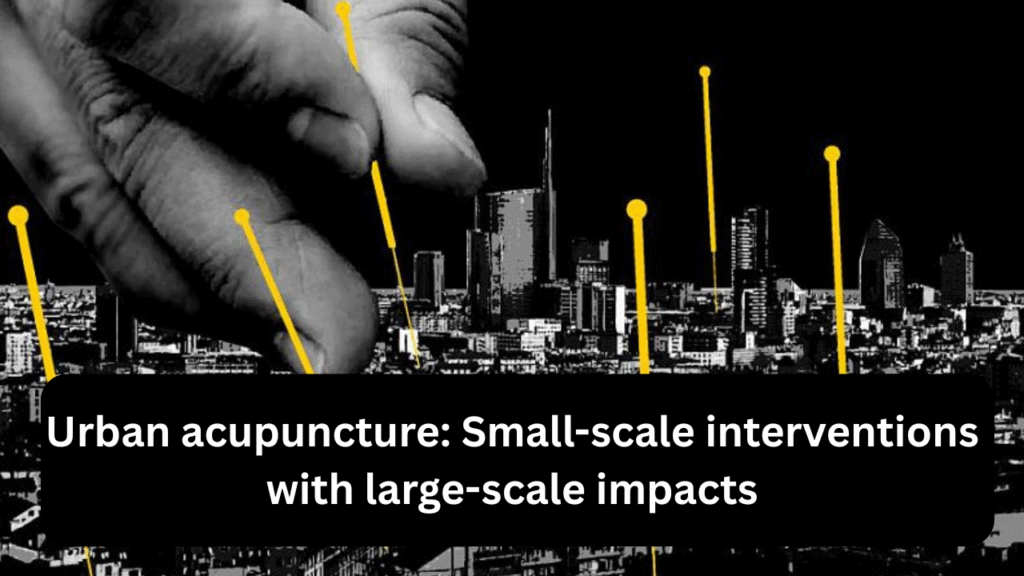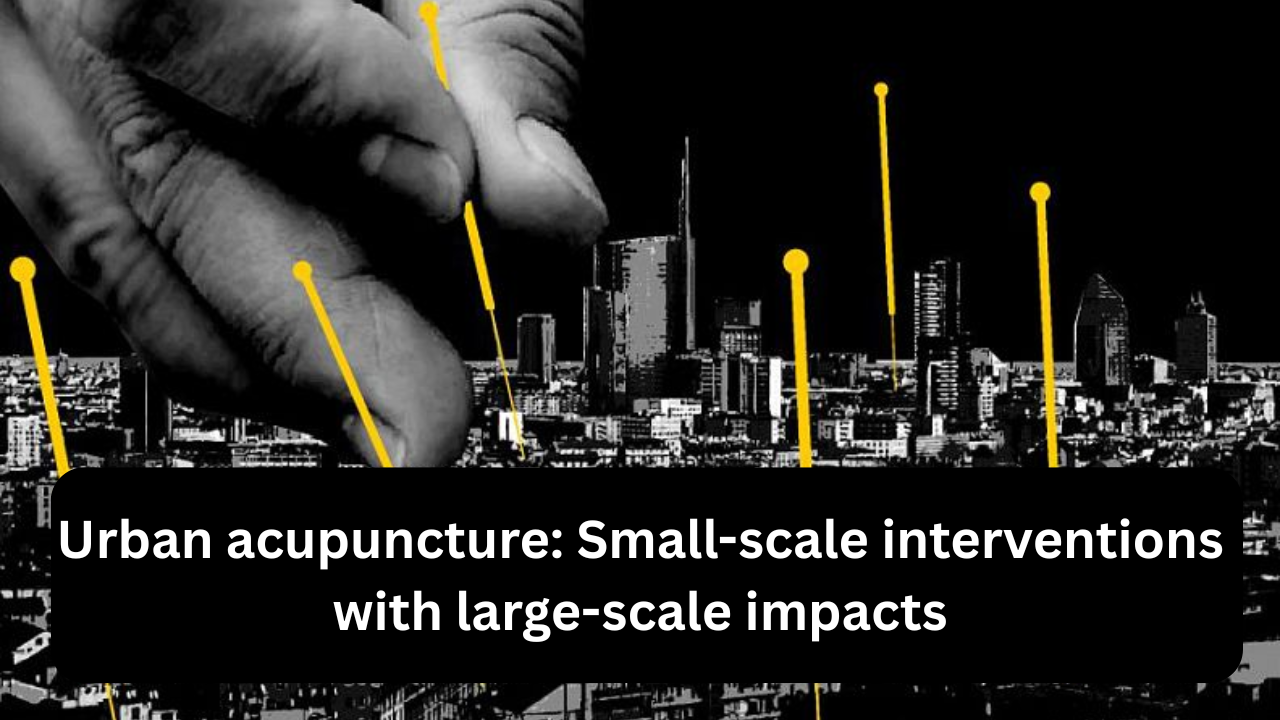
Introduction
In the complex fabric of modern cities, large-scale master plans often dominate urban development strategies. However, a growing movement in urban design—urban acupuncture—focuses on targeted, small-scale interventions that trigger broad positive changes in communities. Much like the medical practice it’s named after, urban acupuncture aims to stimulate key points in a city to revitalize its social, cultural, and environmental health.
What is Urban Acupuncture?
Urban acupuncture is an incremental and community-focused approach to urban renewal. Instead of overhauling entire districts at once, it identifies “pressure points” in the urban landscape—places where strategic, small improvements can spark significant ripple effects across neighborhoods.
These interventions can be physical (like installing a pocket park), social (hosting pop-up events), or ecological (introducing greenery in paved areas). The emphasis is on impact, not scale—small projects that create visible, lasting change.
Why Urban Acupuncture Works
- Low Cost, High Return: Small-scale interventions require fewer resources but can attract significant public engagement.
- Faster Implementation: Projects can be executed quickly, allowing residents to see immediate benefits.
- Community Ownership: Involving locals in the process builds pride and responsibility for maintaining improvements.
- Flexibility: Can adapt to changing needs and urban dynamics without the constraints of massive infrastructure projects.
Types of Urban Acupuncture Interventions
1. Pocket Parks and Micro-Greenspaces
Transforming underused lots, alleys, or small plots into green oases improves air quality, reduces heat islands, and provides community gathering spots.
2. Street Furniture and Art Installations
Benches, murals, sculptures, and lighting enhancements can instantly make spaces more inviting and safe, encouraging public use.
3. Tactical Urbanism
Temporary street closures, pop-up bike lanes, or weekend markets can test ideas before committing to permanent infrastructure changes.
4. Green Corridors and Pollinator Pathways
Planting small strips of vegetation between sidewalks and roads can support biodiversity and connect fragmented habitats.
5. Community-Driven Revitalization Projects
Graffiti clean-ups, wall art projects, or DIY planters allow residents to directly shape their environment.
Benefits of Urban Acupuncture
| Benefit Area | Key Impact | Example Intervention |
|---|---|---|
| Environmental | Improves microclimate | Pocket parks, vertical gardens |
| Social | Fosters interaction | Outdoor seating and public art |
| Economic | Boosts local commerce | Street markets and festivals |
| Safety | Reduces crime through active use | Lighting upgrades |
| Cultural | Strengthens identity | Murals reflecting local heritage |
| Experimental Value | Tests new ideas | Pop-up bike lanes |
Global Examples
1. Medellín, Colombia – Escalators in Comuna 13
Instead of massive infrastructure overhauls, Medellín installed outdoor escalators in steep neighborhoods, improving accessibility and boosting social cohesion.
2. New York City – Times Square Pedestrianization
A small-scale pilot closing parts of Broadway to cars turned into a permanent pedestrian plaza, increasing foot traffic and local business revenues.
3. Copenhagen, Denmark – Superkilen Park
A multicultural neighborhood park designed with community input, incorporating diverse cultural symbols into a vibrant public space.
Implementation Challenges
- Funding Sustainability: While cheaper than mega-projects, consistent funding is still needed for maintenance.
- Community Resistance: Not all residents may initially support changes, especially if they alter traditional uses of space.
- Coordination Across Agencies: Even small projects may require multiple permissions and collaboration between city departments.
- Measuring Impact: Success is not always immediately quantifiable, making it harder to justify in formal planning processes.
Strategies for Success
- Identify the Pressure Points: Use community surveys, mapping, and urban analysis to find areas where small changes can have big impacts.
- Engage the Community Early: Invite residents to co-design interventions to build trust and ensure cultural relevance.
- Leverage Partnerships: Collaborate with local businesses, NGOs, and artists to share resources and skills.
- Prototype Before Committing: Use temporary installations to test concepts and gather feedback.
- Scale Up Gradually: Successful pilot projects can be replicated in other parts of the city.
Overview Table
| Aspect | Traditional Urban Projects | Urban Acupuncture Approach |
|---|---|---|
| Scale | Large, city-wide | Small, site-specific |
| Implementation Time | Years | Weeks to months |
| Cost | High | Low to moderate |
| Community Role | Limited consultation | Active participation |
| Flexibility | Low – fixed design | High – adaptable |
| Impact Reach | Gradual | Immediate and ripple-based |
Conclusion
Urban acupuncture is proof that small ideas can have big consequences. By focusing on key points in the city and introducing targeted improvements, urban designers, policymakers, and communities can unlock the hidden potential of neglected spaces. This approach empowers residents, enhances livability, and builds more adaptable, resilient cities without the delays and costs of massive redevelopment plans.
3 Quick FAQs
Q1: Is urban acupuncture only about physical design changes?
A: No, it can also include cultural, social, and environmental initiatives that influence community life.
Q2: Can urban acupuncture work in rural or small towns?
A: Yes—small interventions can revitalize town centers, public squares, and community hubs anywhere.
Q3: How soon can results be seen from urban acupuncture projects?
A: Often within weeks, as interventions are quick to implement and immediately visible.

